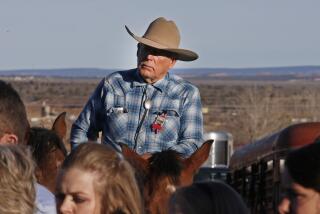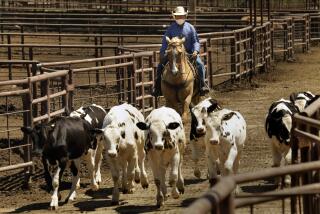Saddling up at a working cattle operation
THE HEIFERS are acting surly, but my horse pushes forward. My young crew of 10 or so cowpunchers encircles about 30 head of cattle on a wide pasture in the shadow of a sawtooth mountain just west of Bridgeport. Our horses slowly lead the cattle toward a gate at the far end of the field.
“Move on,” I yell, as I nudge my mount with the heel of my boot. “Heeeaaah!”
For a moment, I think I’m a cow-herding, range-riding, genuine cowboy.
Whom am I fooling? I’m just a part-time pretender, one of several dozen greenhorns playing cowboy at a dude ranch only a few miles from a 24-hour convenience store, a corner deli and a big-box retailer. I have donned a pair of old boots and mounted a swayback horse because I think I have the grit and guts to cut it as a cowboy.
At least, that’s what I thought.
My grandfather Alejandro was a real cowboy. He had leathery brown hands, a frozen squint and a faded black cowboy hat perched on his head. Back in Mexico, he milked cows, slopped pigs and rode a horse into town for supplies.
Two generations later, I’m a fully integrated part of modern city life, with soft, office-worker hands, iPod buds jammed in my ears and a cellphone clipped to my belt.
So I was thrilled at the idea of spending a week at an authentic working cattle ranch, where I was sure my deep-rooted vaquero instincts would emerge.
But dude ranches today are more like resorts. Even the ranch depicted in Billy Crystal’s 1991 comedy, “City Slickers,” looks grueling by today’s standards. Liability fears and tough competition from resorts and cruise lines have forced dude ranchers to adjust, according to the folks at the Dude Ranchers’ Assn., an alliance of more than 100 guest ranches in the Western U.S. and Canada.
That means no potentially risky guest activities, such as cattle branding or horseshoeing. Instead, visitors enjoy swimming pools, hot tubs, saunas and tennis courts.
Grandpa, I am sure, is spinning in his grave.
My search for an authentic cowboy experience leads me to the Hunewill Guest Ranch, on the outskirts of Bridgeport, about 360 miles north of Los Angeles. The 4,500-acre working ranch sits in a wide, flat valley between Yosemite National Park and Bridgeport. More than 190 horses and about 2,400 head of cattle call the sage-studded valley home. The Dude Ranchers’ Assn. tells me this is one of the few places that has resisted the resort trend.
In the early 1800s, Napoleon Bonaparte Hunewill struck out from Maine, hoping to make a fortune in gold and timber. He homesteaded and founded the Hunewill ranch in 1861. In the wake of the Great Depression, his descendants opened the ranch to guests. Today, Hunewill’s great-great-grandchildren run the business.
On paper, the place sounds authentic. But during my weeklong stay this June, I learn that even Napoleon’s offspring have had to adjust to modern times. And I realize I don’t mind at all.
MEETING THE MOUNTS
“Grayson!”
“Tyson!”
“Tequila!”
“Elmo!”
The sun crests over the Sweetwater Mountains east of Bridgeport as a dozen wranglers saddle horses on a dirt lot in front of the ranch’s sun-parched barn.
The wranglers holler out the horses’ names, each of which has been assigned to a visitor for the week. About 50 guests -- nearly half are younger than 14 -- wait at the edge of the lot to hear their horses’ names. Mine is Murphy, a muscular bay with a sagging spine and big, soulful eyes.
The horses’ hoofs clip-clop as we saunter out to nearby fields encircled by barbed wire and intersected by ditches and channels that feed the wild purple irises and pale green sage in the pasture.
Mornings begin this way: After breakfast, we assemble for a horse roll call and then ride into the fields. The wranglers separate us into three groups based on riding skills. I’m relegated to the buckaroos, a euphemism for greenhorns.
Each day, we work on our riding skills. I start as a novice, learning to turn, stop and keep my butt in the saddle. But by the end of the week, I’m racing across open fields, leaping over ditches, squealing like a kid, my horse’s mane flying in the wind.
During breaks, we sit high in our saddles and listen as our wranglers recite a verse or two of cowboy poetry. Most of our wranglers are grizzled cowboys, sporting dusty spurs and CD-size belt buckles. So it’s strange and somewhat sweet to hear such sentimentality from these leathery ranch hands.
Sallie Joseph, a big-framed wrangler with flowing brown hair, gets a faraway look in her eyes as she recites an original poem about life on the range.
There’s a little something extra here
That’s no match for any job’s wage.
The sound of the wind through the juniper trees,
And the smell of rain on the sage.
Still, the spirit of Tom Mix and Roy Rogers has yet to take hold of me, even later that evening when the wranglers try to teach us how to throw a lasso around a faux steer behind the ranch house.
One night, as the sun sets behind the Sierra Nevada, I drain a beer on the porch of my cabin, which overlooks a large grassy quad where a couple of boys play ball with several of the ranch border collies.
Sharing the porch with me is Bruce Forsythe, a retired dentist from Sebastopol. He sips red wine, and we chat about fishing, writing and family life. His parents first brought him to the ranch in the 1960s, and now he returns each year with his daughter, Samantha, now 14.
He says he likes that the ranch’s guests are not distracted by modern electronics. The simple but comfortable cabins resemble ultra-economy hotel rooms: no TVs or phones, no minibars or coffee makers. For a touch of kitsch, the room includes a hat rack made of welded horseshoes. Don’t expect high-end cuisine at the dining hall. The menu boasts mom-and-pop-diner meals -- burgers, steaks and pasta.
Each night after dinner, the guests saunter from their cabins for a gathering. One night, we roast marshmallows around a campfire while our wranglers play guitars and sing country tunes. Another night, we try to milk a cow. The next night, we jump on a horse-drawn hay wagon for a ramble. One evening, the kids -- and a few adults -- put on a talent show, with skits, magic tricks and more sentimental cowboy poetry.
Later in the week, I meet Betsy Hunewill Elliott, the great-great-granddaughter of the ranch founder. She’s the ranch boss now. Her brother and sister help out too. The Hunewills have already added some resort-like amenities, such as a full-time masseuse and, beginning this year, Wi-Fi access.
And now, she says, the Hunewills are pondering even more amenities, such as a hot tub. But she is leery about changing the character of the ranch, which has been in her family for nearly 150 years.
Of modernizing, she says, “We are torn.”
HEAD ‘EM OUT
My first taste of real cowboy work comes on my third day at the ranch when the wranglers ask guests to help move cattle from various pastures. In the field, about 10 of us form a moving column, slowly tightening our circle around a herd of brown-and-white heifers. Without prodding, our horses close in on the cattle. A few heifers briefly rebel, refusing to yield until they come nose to nose with our advancing column.
Next our crew circles a group of Angus steers we must move to another field. These fierce-looking beasts -- the pit bulls of bovines -- are tall and thick in the shoulder, but they offer little resistance as our horses approach.
Three hours of cowpunching and I ride back to the barn, thinking I may have what it takes to be a real cowboy. But reality sinks in when I get off my horse and waddle to my cabin to relieve my sore muscles with some ibuprofen and a chilled bottle of pale ale.
Toward the end of the week, I tackle another cowboy tradition: ambling. The wranglers move our horses by trailer to a lakeside campground about five miles east of the ranch, on the outskirts of the Hoover Wilderness. About 20 of us would-be cowboys follow in cars. We pack sandwiches and water bottles in our saddlebags and ride into the Sierra wilderness.
A dirt and rock trail leads us to Barney Lake, a deep blue mountain pool that was first stocked with cutthroat trout by Napoleon’s son Frank Hunewill in the late 1800s.
The four-mile, single-track path follows the banks of a shallow, fast-moving creek. We are shaded by ponderosa and Jeffrey pine, white cedar and quaking aspen. The mountain breezes make the aspen leaves quiver like butterfly wings. Yellow mule’s ear blooms and purple lupine adorn our path.
We stop to stretch our legs and listen to another cowboy poem -- something about life being a lot like a doughnut.
As we ride, the sound of hoofs and the splashing creek fill the warm mountain air. When the lake comes into view between the pines, even our thick-skinned wranglers can’t help but be stunned. “What a sight,” says one. “Beautiful.”
HANGING UP HIS SPURS
It’s the morning of my final day at the ranch and I’ve joined a group of riders for a few hours of loping and ditch jumping in the pastures. I’ve spent nearly a week in a saddle, and I’ve abandoned the title of “buckaroo.” Maybe I’m not a cowboy yet, but I’m certainly no tenderfoot.
As Murphy and I sprint across the fields, leaping over narrow waterways, I can almost hear the “William Tell” Overture.
Back at the ranch house that afternoon, the wranglers call for volunteers to move more cattle out of a pasture in the western end of the ranch. Not today, I say. All of this riding has taken its toll. I have an hourlong deep-tissue massage scheduled with the ranch’s in-house masseurs.
Sorry, Grandpa.
More to Read
Sign up for The Wild
We’ll help you find the best places to hike, bike and run, as well as the perfect silent spots for meditation and yoga.
You may occasionally receive promotional content from the Los Angeles Times.






